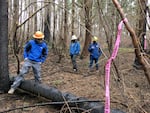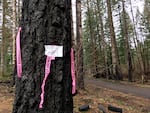A state forest plan that aims to protect endangered species across 640,000 acres of forestland west of the Cascades while providing certainty for logging is moving toward its final stages.
The proposed Western Oregon Habitat Conservation Plan would provide protections for 17 federally listed endangered species and ensure logging in other parts of the forests to limit the potential harm to those species. The species list includes the coastal marten, red tree voles, Northern spotted owl, and Oregon coast coho.

Coho salmon like these are among the salmon species in peril, as outlined in the 2021 State of Salmon in Watersheds report.
U.S. Bureau of Land Management - tinyurl.com/ya4rs6sx
The plan, first developed by the Oregon Department of Forestry in 2018, would protect the agency from potential lawsuits and ensure compliance with the federal Endangered Species Act for land management activities such as timber harvest, construction and maintenance in the state forests over a 70-year period. It would also improve forest conservation strategies and create a fund that could generate an average of $1 million per year to help pay for habitat conservation and enhancement projects for protected species.
National Oceanic and Atmospheric Administration and the Fish and Wildlife Service released a draft environmental review of the plan and are currently accepting public comments. The agencies will review public comments and issue a final plan sometime next year, and then the plan will go to the Oregon Board of Forestry for final approval.
ODF’s Deputy Division Chief of Policy and Technical Support Michael Wilson said he believes this is the agency’s best effort to come up with a plan that provides a balance of conservation, species protection, recreation and continued timber harvest in state forests.
“It’s essential that we provide a foundation that provides certainty that we can still make the forest accessible in all those ways going forward,” he said.
ODF spokesman Jason Cox said the plan is designed to provide cleaner water and high-quality habitat conservation while allowing for timber harvest, which also funds the agency’s state forest programs, and benefits local counties and rural communities.
Cox said the plan represents a “middle-of-the-road approach” because of how much input there’s been from conservation groups, the timber industry, and residents in counties where the state forests are located.
Conservation groups agree the plan does strike a balance but more could have been done to increase environmental protection.
Brett Brownscombe with the Wild Salmon Center environmental group said while the plan does provide a vision for more conservation, he expected ODF to reform its business model to reduce the agency’s reliance on timber revenue.

A log truck on the Trask River road near Tillamook.
Amelia Templeton / OPB
“There just has to be something more robust than simply relying upon logging to serve the broad public values that people want to see on their state public lands,” he said.
Brownscombe said the public wants to see conservation as well as new opportunities for communities that haven’t been the primary focus of state forest management. He said the state could get more money from the general fund for rural school districts and services to alleviate their dependence on logging in state forests.
Benton County Commissioner Nancy Wyse said many counties do rely on timber harvests for revenue, and right now expenses for local governments have been rising faster than what’s coming in.
“Several county commissioners have expressed concern that their revenues could be negatively impacted because of reduced timber harvests,” Wyse said.
But she said the state has an “ethical” obligation to prioritize conservation and the protection of species and ultimately she hopes the plan will help guide the state through the challenge of finding a balance that works for everyone.
Associated Oregon Loggers Forest Policy Manager Amanda Sullivan-Astor said that balance can be achieved by creating meaningful outcomes for protected species like the Northern spotted owl while still maintaining employment in Oregon’s forest sectors.
She said one strategy would be stabilizing the Northern spotted owl’s population on state forestland. One of the ways to do that, she said, would be managing the barred owl’s population, which covers the same territorial range and is a known competitor to the spotted owl.

The northern spotted owl is on a slow but steady course toward extinction.
Todd Sonflieth / OPB
“The caretakers of these forests, who grow, harvest and protect them, will be irreversibly harmed by the reduction of forest management in all of the alternatives, and I fear forest health will suffer with them,” Sullivan-Astor said.
The draft plan currently offers proposed action and alternatives the federal government can choose from that include taking no action to increase conservation or increase timber harvest. But Sullivan-Astor said after taking a closer look, none of the alternatives stabilize or increase logging.
The public can comment on the Western Oregon State Forests Habitat Conservation Plan until May 17. There will also be a virtual public meeting on April 6 where comments will also be accepted.






















